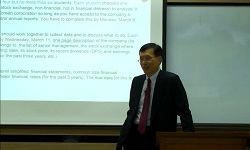Signaling theory argues that managers use dividend policy to signal the future prospects of firm`s operational performance. According to the theory, the future operational performance would be enhanced after the firm increases dividends. In this paper...
http://chineseinput.net/에서 pinyin(병음)방식으로 중국어를 변환할 수 있습니다.
변환된 중국어를 복사하여 사용하시면 됩니다.
- 中文 을 입력하시려면 zhongwen을 입력하시고 space를누르시면됩니다.
- 北京 을 입력하시려면 beijing을 입력하시고 space를 누르시면 됩니다.
https://www.riss.kr/link?id=A87029416
- 저자
- 발행기관
- 학술지명
- 권호사항
-
발행연도
2011
-
작성언어
-
- 주제어
-
KDC
300
-
등재정보
KCI등재
-
자료형태
학술저널
-
수록면
1-32(32쪽)
-
KCI 피인용횟수
10
- DOI식별코드
- 제공처
-
0
상세조회 -
0
다운로드
부가정보
다국어 초록 (Multilingual Abstract)
Signaling theory argues that managers use dividend policy to signal the future prospects of firm`s operational performance. According to the theory, the future operational performance would be enhanced after the firm increases dividends. In this paper, we investigate the information content of dividend. Specifically we examine whether dividend policy changes have the predictive power to the future earnings, using the sample of firms which have been continuously listedon Korean Stock Exchange during the period of year 2003 to 2009. We also include stock repurchase in firm`s dividend policy. Dividend payout ratio, which is the commonly used variable for dividend policy, has a logical limitation in measuring the cross-sectional variations of firms` dividend policy in Korea. Considering the regulations on dividend payment in Korean firms, we suggest that the appropriate proxy variable of dividend policy in Korea is the ratio of dividend to distributable income, not to net income. The ratio of dividend to distributable income appropriately reflects firm`s dividend changes relative to its earnings. Our empirical resutls show that the ratio of dividend to distributable income does not have any predictive power to the change of future ordinary income, oroperating income. Instead, there exists a significant negative correlation between dividends and future earnings, which are contrary to signaling theory. The results still hold even if we include stock repurchase in firms` payout. Our empirical results overall provide evidence against the concept of information content of dividend in Korea.
참고문헌 (Reference)
1 전성일, "추정손익계산서 작성에 의한 회계이익 예측에 관한 연구" 한국회계학회 12 (12): 1-28, 2003
2 육근효, "주주-경영자간의 대리문제에 관한 실증분석" 11 : 54-164, 1989
3 설원식, "외국인투자가 기업의 배당에 미치는 영향" 한국증권학회 333-357, 2005
4 주재근, "외국인지분율과 기업배당정책에 관한 실증연구" 한국상업교육학회 17 : 447-470, 2007
5 김철중, "소유권구조, 자본조달정책 및 배당정책의 상호관련성에 관한 연구" 13 (13): 51-78, 1996
6 조지호, "배당중심으로 본 주주-경영자간의 대리문제에 관한 연구" 11 (11): 75-89, 1990
7 김동욱, "배당의 정보효과에 관한 실증적 연구" 6 (6): 97-112, 1989
8 조영석, "배당성향과 미래이익성장에 관한 연구" 한국산업경제학회 20 (20): 1445-1462, 2007
9 박영규, "배당변화를 통한 기업의 미래이익 예측가능성 연구" 한국증권학회 33 (33): 63-94, 2004
10 심상규, "동태적 패널모형의 회계이익률 예측능력 검증" 한국회계학회 29 (29): 29-58, 2004
1 전성일, "추정손익계산서 작성에 의한 회계이익 예측에 관한 연구" 한국회계학회 12 (12): 1-28, 2003
2 육근효, "주주-경영자간의 대리문제에 관한 실증분석" 11 : 54-164, 1989
3 설원식, "외국인투자가 기업의 배당에 미치는 영향" 한국증권학회 333-357, 2005
4 주재근, "외국인지분율과 기업배당정책에 관한 실증연구" 한국상업교육학회 17 : 447-470, 2007
5 김철중, "소유권구조, 자본조달정책 및 배당정책의 상호관련성에 관한 연구" 13 (13): 51-78, 1996
6 조지호, "배당중심으로 본 주주-경영자간의 대리문제에 관한 연구" 11 (11): 75-89, 1990
7 김동욱, "배당의 정보효과에 관한 실증적 연구" 6 (6): 97-112, 1989
8 조영석, "배당성향과 미래이익성장에 관한 연구" 한국산업경제학회 20 (20): 1445-1462, 2007
9 박영규, "배당변화를 통한 기업의 미래이익 예측가능성 연구" 한국증권학회 33 (33): 63-94, 2004
10 심상규, "동태적 패널모형의 회계이익률 예측능력 검증" 한국회계학회 29 (29): 29-58, 2004
11 김권중, "기업가치 평가와 회계연구" 한국회계학회 2005
12 박경서, "국내기업의 배당형태와 투자자의 반응에 관한 연구" 한국재무학회 16 (16): 195-229, 2003
13 Fairfield, P., "Using Asset Turnover and Profit Margin to Forecast Changes in Profitability" 6 : 371-385, 2001
14 Penman, S. H., "The Predictive Content of Earnings Forecasts and Dividends" 38 (38): 1181-1199, 1983
15 Watts, R., "The Information Content of Dividends" 46 (46): 191-211, 1973
16 Denis, D. J., "The Information Content of Dividend Changes: Cash Flow Signaling, Overinvestment, and Dividend Clienteles" 29 (29): 567-587, 1994
17 Asquith, P., "The Impact of Initiating Dividend Payments on Shareholders’ Wealth" 56 : 77-96, 1983
18 Arnott, R. D., "Surprise! Higher dividends= Higher Earnings Growth" 59 (59): 70-88, 2003
19 Ball, R., "Some Time Series Properties of Accounting Income" 27 (27): 66-682, 1972
20 Aharony, J., "Regular Dividend Announcements and Future Unexpected Earnings: An Empirical Analysis" 29 (29): 125-151, 1994
21 Nissim, D., "Ratio Analysis and Equity Valuation: From Research to Practice" 6 (6): 109-154, 2001
22 Aharony, J., "Quarterly Dividend and Earnings Announcements and Stockholders’ Returns: An Empirical Analysis" 35 (35): 1-12, 1980
23 Little, I. M. D., "Higgledy Piggledy Growth Again" Basil Blackwell 1966
24 Little, I. M. D., "Higgledy Piggledy Growth" 24 (24): 1962
25 Fama, E., "Forecasting Profitability and Earnings" 73 (73): 161-175, 2000
26 Penman, S. H., "Financial Statement Analysis and Security Valuation" McGraw-Hill 2001
27 Healy, P. M., "Earnings Information Conveyed by Dividend Initiations and Omissions" 21 (21): 149-175, 1984
28 Benartzi, S., "Do Changes in Dividends Signal the Future or the Past" 52 (52): 1007-1034, 1997
29 DeAngelo, H., "Dividend Policy and the Earned/contributed Capital Mix: a Test of the Life-cycle Theory" 81 : 227-254, 2006
30 Zhou, P., "Dividend Payout and Future Earnings Growth" 62 (62): 58-69, 2006
31 Nissim, D, "Dividend Changes and Future Profitability" 56 (56): 2111-2133, 2001
32 Grullon, G., "Dividend Changes Do not Signal Changes in Future Profitability" 78 (78): 1659-1682, 2005
33 Pettit, R. R., "Dividend Announcements, Security Performance, and Capital Market Efficiency" 27 (27): 993-1007, 1972
34 Ohlson, J., "Disaggregated Accounting Data As Explanatory Variables for Returns" 7 : 553-578, 1992
35 Ofer, A. R., "Corporate Financial Policy, Information, and Market Expectations: An Empirical Investigation of Dividends" 42 (42): 889-911, 1987
36 Freeman, R., "Book Rate-of-Return and Prediction of Earnings Changes: An Empirical Investigation" 20 (20): 639-653, 1982
37 DeAngelo, H., "Are Dividends Disappearing? Dividend Concentration and the Consolidation of Earnings" 72 : 425-456, 2004
38 Dielman, T. E., "An Examination of Investor Behavior During Periods of Large Dividend Changes" 19 (19): 197-216, 1984
39 Fairfield, P., "Accounting Classification and the Predictive Content of Earnings" 71 (71): 337-356, 1996
동일학술지(권/호) 다른 논문
-
- 한국금융공학회
- 홍정효 ( Chung Hyo Hong )
- 2011
- KCI등재
-
- 한국금융공학회
- 김주일 ( Joo Il Kim )
- 2011
- KCI등재
-
소유경영기업과 전문경영기업의 소유 지배괴리 도와 기업가치
- 한국금융공학회
- 김동회 ( Dong Hoe Kim )
- 2011
- KCI등재
-
- 한국금융공학회
- 신민식 ( Min Shik Shin )
- 2011
- KCI등재
분석정보
인용정보 인용지수 설명보기
학술지 이력
| 연월일 | 이력구분 | 이력상세 | 등재구분 |
|---|---|---|---|
| 2026 | 평가예정 | 재인증평가 신청대상 (재인증) | |
| 2020-01-01 | 평가 | 등재학술지 유지 (재인증) |  |
| 2017-01-01 | 평가 | 등재학술지 유지 (계속평가) |  |
| 2014-03-25 | 학술지명변경 | 외국어명 : Korean Association of Financial Engineering -> Korean Journal of Financial Engineering |  |
| 2014-03-17 | 학회명변경 | 영문명 : The Korean Journal Of Financial Engineering -> Korean Association of Financial Engineering |  |
| 2014-03-14 | 학술지명변경 | 외국어명 : The Korean Journal of Financial Engineering -> Korean Association of Financial Engineering |  |
| 2013-01-01 | 평가 | 등재학술지 유지 (등재유지) |  |
| 2010-01-01 | 평가 | 등재학술지 선정 (등재후보2차) |  |
| 2009-01-01 | 평가 | 등재후보 1차 PASS (등재후보1차) |  |
| 2008-01-01 | 평가 | 등재후보 1차 FAIL (등재후보1차) |  |
| 2006-01-01 | 평가 | 등재후보학술지 선정 (신규평가) |  |
학술지 인용정보
| 기준연도 | WOS-KCI 통합IF(2년) | KCIF(2년) | KCIF(3년) |
|---|---|---|---|
| 2016 | 0.38 | 0.38 | 0.55 |
| KCIF(4년) | KCIF(5년) | 중심성지수(3년) | 즉시성지수 |
| 0.61 | 0.66 | 1.029 | 0 |




 KCI
KCI KISS
KISS




